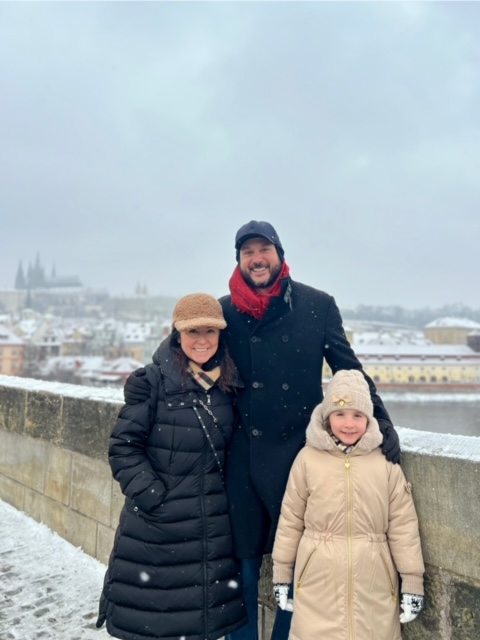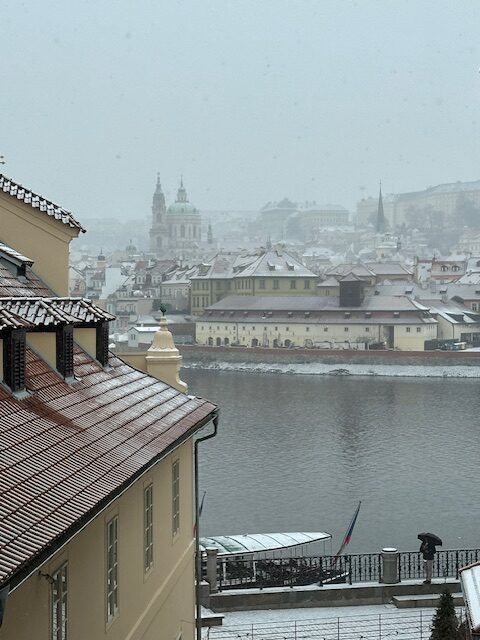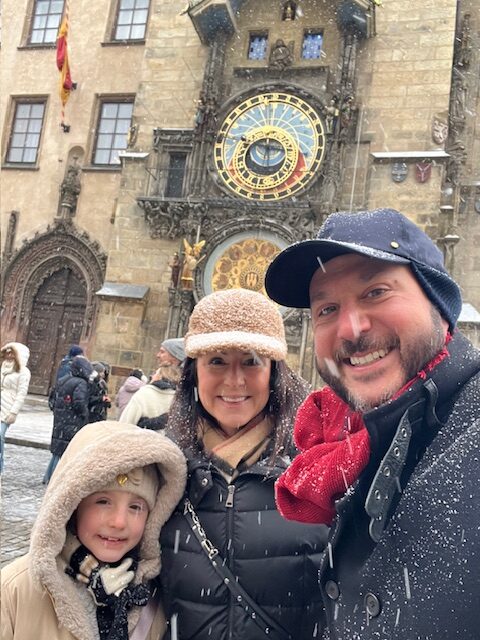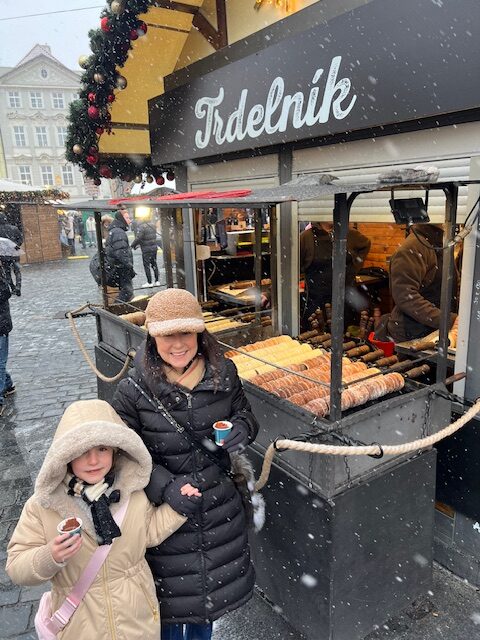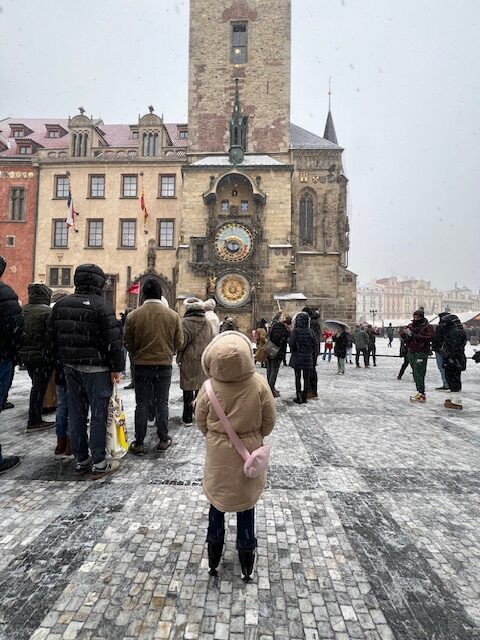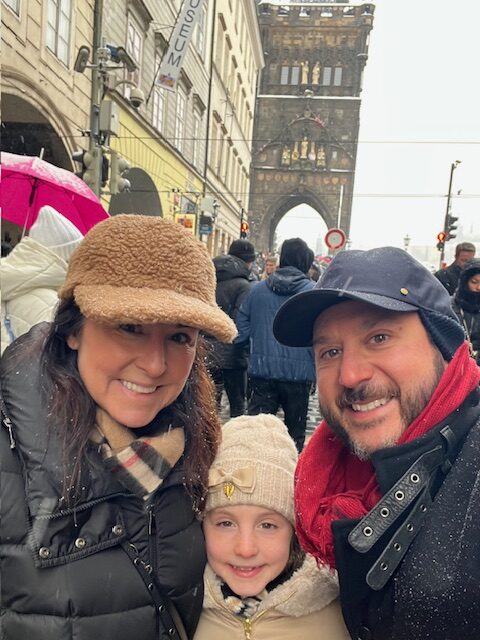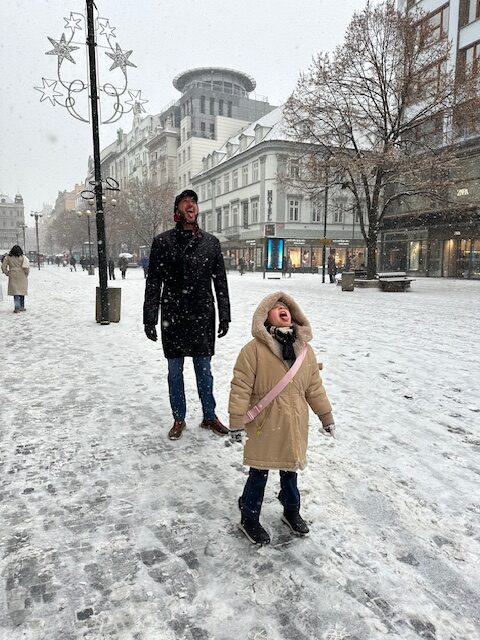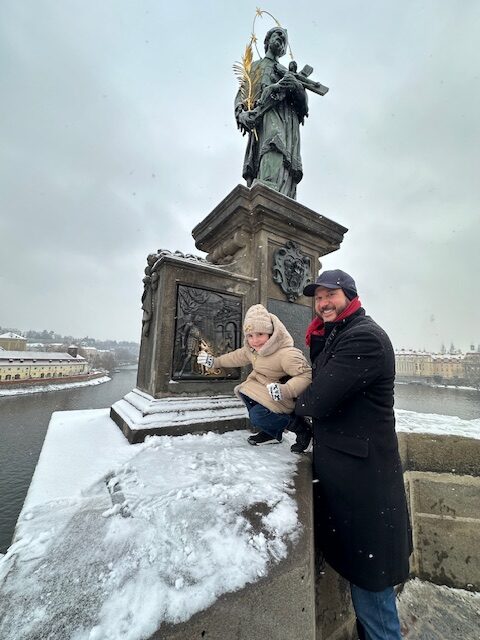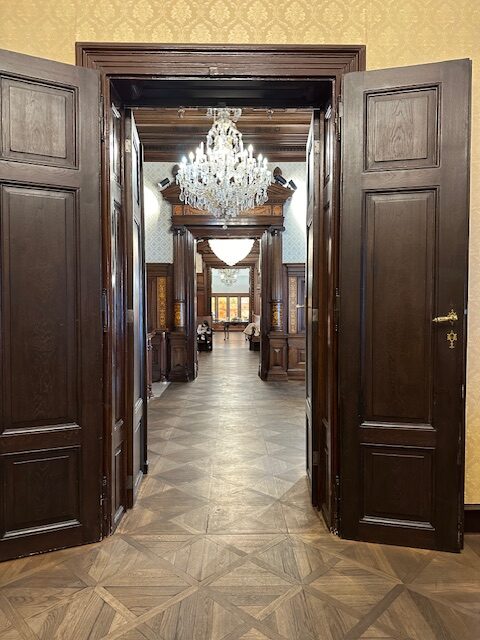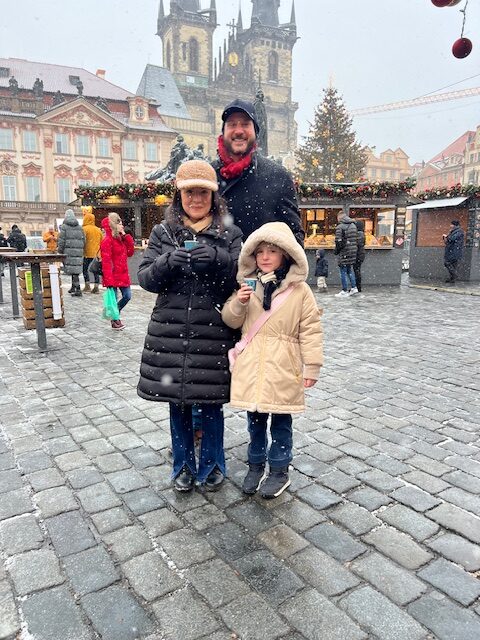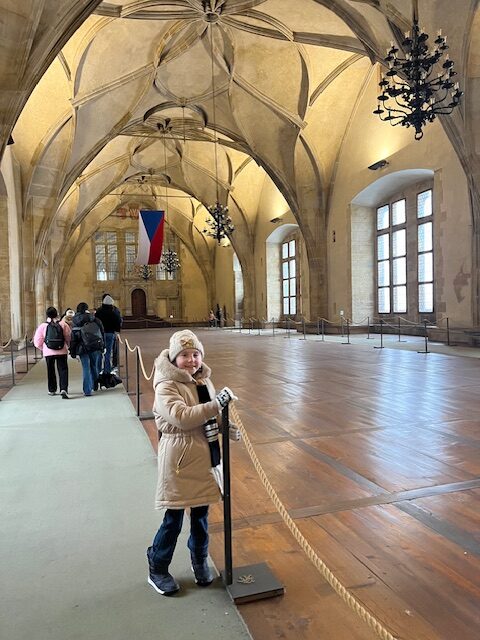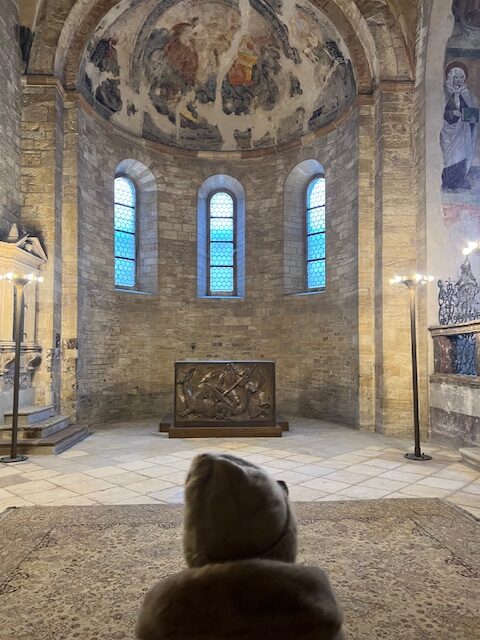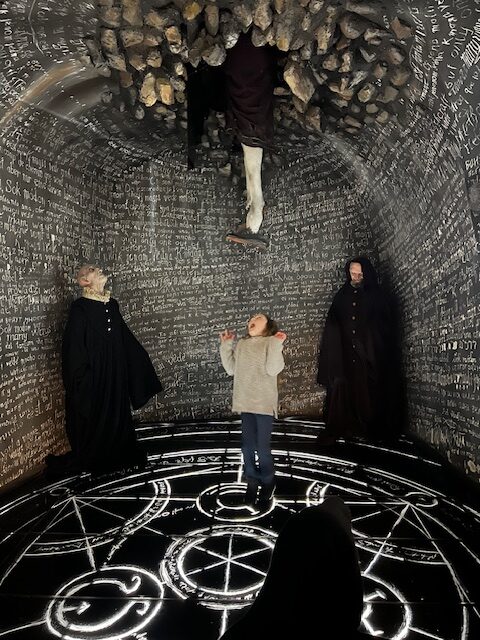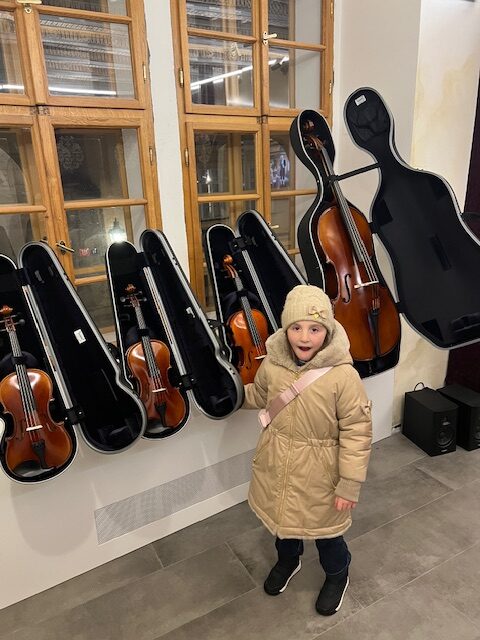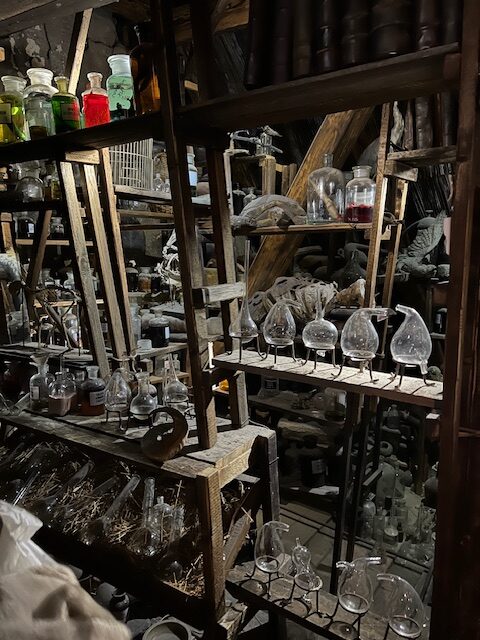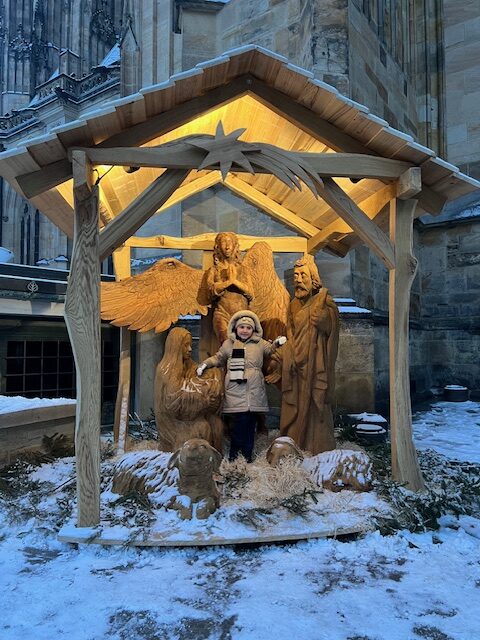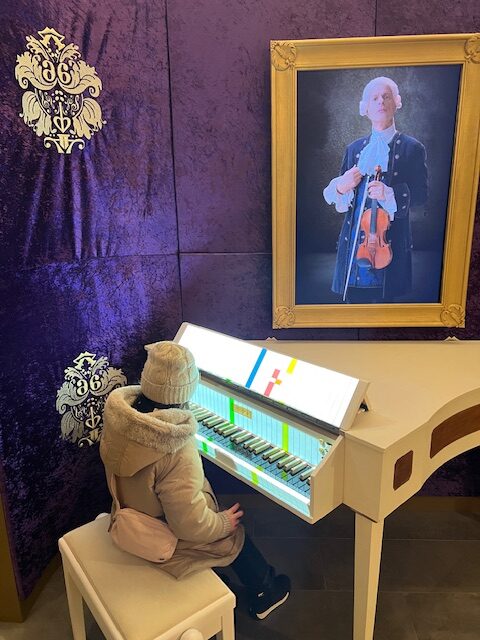Our intended flight to Prague would have gotten us in around 1PM. We figured we would have that day to explore the Mala Strana (or Old Town). Then, we could spend the next day at the Prague Castle. However, the universe had other plans, as we learned when they canceled our flight while we were waiting in line to check our bags. That left us with just enough time for dinner on our first night in Prague and a full day of exploration on our second. It wasn’t enough to see all of Prague’s glory, but that’s okay. There really wasn’t a better place for things to work out exactly as they did.
Jamil and I got married in Prague in 2010, and we’ve had the chance to wander the city’s nooks and crannies, both on our own and with a guide. Prague is a fabulous, historic city with a complicated history, really too complicated for Josephine to understand at eight years old. Prague is somewhere we’d have to revisit under any circumstances to give her a fair shake at grasping the city’s significance. And the little time we had there successfully whetted her appetite; she loved it and can’t wait to return.
Here’s what we did in the short time we had:
1. First, a walk through the Old Town.
Luckily, the Christmas Market was still in full effect. It was so lively and fun, and we couldn’t help but stop for an early-morning cup of hot chocolate that boldly proclaimed itself, “The Best Hot Chocolate in the World.” That was too tempting. We had to find out if it was true. And it was!
We also walked over to the famous Orloj, the medieval astronomical clock that is attached to Prague’s Old Town Hall. The clock is mesmerizing. The clock was created in 1410. It shows the rotation of the zodiac, reflecting the Sun’s location and the Moon’s, as well as tells the time. And it has these magnificent figures that move around the clock every hour, representing Greed, Vanity, Death, and Lust. Furthermore, the Twelve Apostles appear on the hour. So people tend to stand and wait for the hour to strike, so they can watch the Orloj do its thing.
The clock has particular significance to us because my parents were sitting in the square, having a glass of wine and admiring the clock’s design, when they struck up a conversation with the Portuguese gentleman at the next table. They talked and talked, and eventually exchanged contact information. He turned out to be the Minister of Energy for Portugal, and would you believe that we wound up connecting with his family in Portugal not once, but twice? We would call them again if we went to Lisbon, and I hope they’d call us if their paths led them to Houston.
2. Shopping at the Moser store in the Old Town.
This year, I couldn’t think of anything I wanted for Christmas. What I really wanted was to go to Europe and shop for beautiful things. One thing I’d been pondering was purchasing new crystal glassware. Jamil and I adore having friends over for drinks and dinner; it only makes sense that we should invest in some pretty pieces to serve our guests.
Moser Crystal is spectacular. The company has been producing intricately engraved glassware for almost 200 years. It has supplied crystal to the monarchs of Austria-Hungary, Persia, England, the Vatican, and so many others. And when you visit the Moser store in Prague, you can feel how special the pieces are.
The Moser store is set in an old palatial home that has original, highly detailed wood paneling and wonderfully tall ceilings. The pieces are on display behind glass, for the most part, lest a clumsy customer shatter a work of art.
Jamil and I found a pattern we loved, and we purchased several glasses to send back to the United States. We intend to buy more over time and eventually complete the collection. I will look at them forever and think of this precious time together with our amazing daughter.
When my mother died, I learned that you can only hold onto so much. Maybe these glasses will be among the heirlooms Josephine chooses to add to her own collection when we’re gone.
3. Walk across Charles Bridge to Prague Castle
The Charles Bridge dates to 1357. It’s lined with 30 baroque statues, and while conservationists argue that renovations of Charles Bridge have been shoddy throughout history, ignorance is bliss. It looks great to me!
It was snowing as we made our way across the bridge, a phenomenon that made a beautiful landmark even more breathtaking. As Josephine pointed out, the snow created a sort of reverse shadow, covering all of the crevices with white. It was so special.
If you go, don’t forget to rub the dog on the St. John of Nepomuk statue. It will bring you good luck! And you should have no trouble finding the exact spot to rub: unlike the majority of the bronze on the bridge, which has darkened from oxidation and pollution, the lucky spots are bright, shiny gold because so many people rub them every day.
4. Prague Castle
Prague Castle is the largest surviving medieval castle. Construction started in the 800s! It housed monarchs of Bohemia and the Holy Roman Empire; it served as the seat of the Czech Republic. And for centuries, people have been coming to the Castle to worship at its awe-inspiring basilicas.
The Basilica of St. Vitus dates to 1344. It was a medieval pilgrimage site because it held (and still holds) the remains of St. Wenceslaus, and it’s one of the few churches in the region that came through WWII intact. There are countless elements of the church that make it worth a visit, but I particularly like the wooden relief carving of Prague from 1630 and the Mosaic of the Last Judgment on the exterior wall of the basilica.
We also visited the Basilica of St. George, which is the oldest building in Prague Castle. Honestly, I know the basilica is important, but it’s worth only a brief look. It’s very simple, which is unsurprising, given its age. The coolest thing about the church is that it holds the remains of some saints, most notably Ludmila of Bohemia, the grandmother of Wenceslaus. She was strangled to death for her commitment to Christianity, so she had a one-way ticket to martyrdom and canonization. She’s considered a patron saint of the region.
The Lobkowicz Palace, the most fabulous, intimate museum ever, is also in Prague Castle, but we opted not to tour the exhibits this time. The last time I was there, I spent upwards of 2 hours, listening to the audio guide and studying each exhibit. I didn’t think Josephine was really ready for that, so we didn’t do it. However, you should know that the Lobkowicz family is really in charge of the Palace. They run the entire operation, and everything is top-notch. We met the family when we were there in 2010, and then by some weird coincidence, one of our clients happened to be closely related to them! They’re committed to the legacy of the Lobkowicz name, so you won’t be disappointed by any of their ventures.
5. The Mozart Interactive Museum
This was a nice museum. It’s huge, set over four floors, and the creators put a lot of effort into making the space fun and educational. For example, they laid out in order from smallest to largest a violin, a viola, a cello, and the like. As you opened the instruments, they began to play their portions of the melody. When you closed the boxes, they stopped playing. You could play any combination of them, and it was very cool. We all liked learning how the various stringed instruments contribute to the sound of a piece. They also had a virtual reality conducting experience and a room where you could spin various cylinders that repressed instruments to make the sounds of those instruments come alive. And throughout the exhibits, they offered insights into Mozart’s life and genius. It was a good way to pass some time and encourage musical interest, if a little cheesy here and there.
6. The Museum of Alchemists and the Ghost Museum
This was not a museum I longed to see. But the ticket was included with another ticket, and we were like, hmmm, why not? Turns out, there are many reasons why not, but it was still better than the Ghost Museum, described below.
The Alchemist Museum is filled with all kinds of garbage, but it does take you up an interesting staircase that the guides say is hundreds of years old. I believed them until I went to the Ghost Museum, which was such a piece of grunge that it made me doubt anything they had to say. We climbed into the attic of a building that was five centuries old and viewed ridiculous installations meant to teach us what alchemists were really into — attempting to grow humans in soil, for example. There were strange taxidermies and bizarre mannequins. Honestly, I’m glad we went because it was THAT weird.
The same cannot be said of the Ghost Museum, which Josephine insisted on touring. Man, Prague has a weak-sauce history of hauntings, or at least they’re presented wretchedly in this ghost museum.
